In French cuisine, sauces are just as important a part of the dish as the meat or side. The concept of five mother sauces provides the base framework from which just about any sauce can be made with a few additional ingredients.
If you've ever eaten macaroni and cheese with bechamel or eggs Benedict drizzled with hollandaise, you've already tasted some of the five mother sauces.
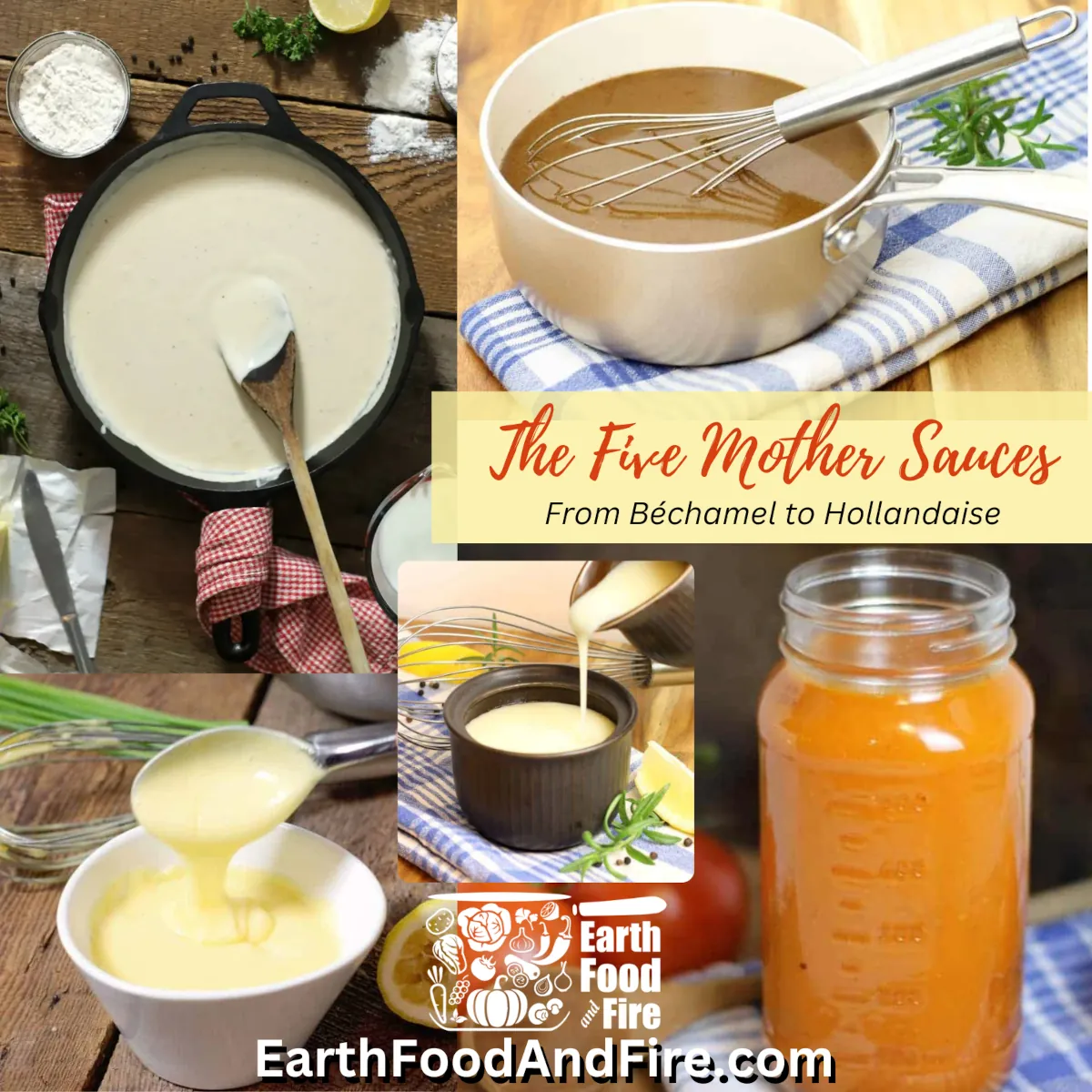
Once you master the five mother sauces - Béchamel, Velouté, Espagnole, Tomato, and Hollandaise - you will understand how sauces work at their core. That, in turn, will give you the confidence to start experimenting with flavors. By adding a few additional ingredients, such as herbs, spices, and stocks, you can create an unlimited number of tasty sauce variations.
In this article, we’ll explore each sauce, explain how it’s made, where it’s commonly used, and what variations you can make. We will also share links to our detailed, tried-and-true recipes so you can make the mother sauces at home.
Whether you're just starting your culinary journey or looking to brush up on the basics, these sauces are in the category of essential kitchen knowledge and are a fantastic base skill for anyone who loves homemade cooking. Sauces are a simple way to add extra and unique flavors to simple dishes, and mother sauces provide the starting base.
This post contains affiliate links for which we may be compensated if a purchase is made through the links provided at no extra cost to you. For more information, please read our affiliate disclosure.
Table of Contents
What Are Mother Sauces?
So what are 'mother sauces'? The five mother sauces are Béchamel, Velouté, Espagnole, Tomato, and Hollandaise.
First defined in the early 19th century by Marie-Antoine Carême in L'Art de la Cuisine Française, there were originally only four mother sauces, which served as the framework or bases from which all other classical sauces could be derived.
In the early 20th century, Auguste Escoffier modernized and codified the mother sauce recipes in his book 'Le Guide Culinaire', adding a fifth sauce (hollandaise). He also created guides for the various derivatives of mother sauces.
If you've ever had meat with gravy, spaghetti with tomato sauce, eggs with hollandaise sauce, or chicken with cream sauce, chances are you've tasted a sauce based on one of the five mother sauces.
Using Traditional Methods For 5 Mother Sauces
Over the years, other chefs have created variations of the five mother sauces, developed new methods of making them, and created shortcuts to achieve comparable results.
For example, you can use cornstarch instead of a roux to thicken certain sauces. But the end result will have a different texture and taste from the one intended with the original method.
Here, we present the traditional methods for making the five mother sauces.
Four of the five mother sauces are thickened by using a roux (a combination of fat and flour). If you are not familiar with how to make and use a roux, we recommend reading the article before diving into the five mother sauces.
The 5 Mother Sauces
So let's get right to it! The five mother sauces, as defined by Escoffier in his book that is considered 'The Culinary Bible' are Béchamel, Velouté, Espagnole, Tomato, and Hollandaise.
1. Béchamel Sauce – The Creamy Classic
Béchamel sauce is a simple white sauce made from milk thickened with butter and a flour roux. Flavored with onion, cloves, and bay leaf, it is smooth, mild, and incredibly versatile.
Béchamel sauce is often used as a base for creamy cheese sauces or in comforting dishes like lasagna, macaroni and cheese, scalloped potatoes, or moussaka.
With just a few ingredients, béchamel is the perfect introduction to homemade sauce cooking and classic French technique.
👉 Read the full instructions: How to Make Béchamel Sauce
Béchamel Sauce Derivatives:
- Mornay Sauce: Melt grated Gruyère and Parmesan cheese into the sauce before adding scalded cream and whole butter.
- Soubis Sauce: Sautée diced blanched onion in butter and add it to the bechamel along with scalded cream and a little sugar. The soubis is simmered until the onion is fully cooked and then strained.
- Cheddar Sauce: Melt grated cheddar cheese into the bechamel, and then season with Tabasco and dry mustard.
- Nantau Sauce: Add heavy cream and crayfish butter before seasoning with paprika to achieve a reddish colour. Best served with crayfish or lobster
- Anchovy Sauce: Add anchovy puree or paste to the bechamel until you get the desired taste.
Homemade Bechamel Sauce (White Sauce) Recipe
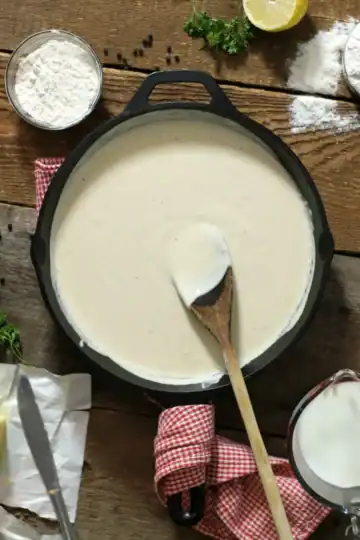
2. Velouté Sauce – Silky and Subtle
Velouté sauce is similar to béchamel, but made with a light stock instead of milk. Traditionally, it uses chicken, fish, or veal stock and is also thickened with a roux.
The result is a smooth, savory sauce that is relatively bland compared to Bechamel. As such, velouté is seldom served as is or on its own, and is mainly used as an intermediary sauce. Its neutral flavor makes it the perfect base for many gravies, creamy soups, and pan sauces.
Velouté is ideal for poultry and seafood dishes, and once you know the basic technique, you can easily adapt it to suit a variety of meals.
👉 Learn how to make it: Velouté Sauce Recipe
The velouté family of sauces is broken into three categories, depending on the stock used: Fish velouté sauces (made with fish stock), Allemande sauces (made with veal stock), and Supreme sauces (made with chicken stock).
Fish Velouté Derivatives:
- Normandy Sauce: Add chopped mushrooms, shellfish liquor (the liquid naturally found in shellfish), fish stock, and lemon to a fish velouté before reducing it and then thickening with a liaison.
- Bercy Sauce: Cook finely diced shallots in butter before adding to a fish velouté.
Allemande Sauce Derivatives:
Allemande sauce in itself is a derivative of velouté. Made by adding lemon juice, and thickened with egg yolks and heavy cream before being strained, it is very delicate and can easily curdle if heated too high.
- Mushroom Sauce: Add sliced mushrooms sautéed in butter to the Allemande sauce along with white wine. Season with parsley and cives,
- Horseradish Sauce: Add dry mustard and cream to an Allemande, along with freshly grated horseradish. Do not cook the horseradish in the sauce, add it fresh as the last ingredient.
- Poulette Sauce: Sautee sliced shallots and mushrooms in butter. Add to the Allemande, simmer, and then strain out. Garnish the resulting sauce with parsley.
Supreme Sauce Derivatives:
The supreme sauce is a chicken velouté that has been reduced with thick cream.
- Hungarian Sauce: Sweat diced onion in butter before adding it to the supreme sauce, along with paprika and white wine. Slightly reduce the sauce, then strain, and finish with a little cream.
- Aurora Sauce: Simmer tomato sauce and cream in a supreme sauce before straining the sauce and then mounting it with butter.
Homemade Velouté Sauce Recipe
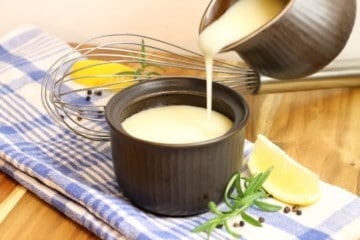
3. Espagnole Sauce – Deep and Rich
Espagnole sauce is a rich brown sauce made from deeply flavored brown stock (usually beef or veal), tomato puree or paste, and a dark roux. It's more complex than the other four sauces, as it requires some patience and time to prepare. Therefore, it's best prepared in batches and frozen for later use.
As a bonus for your efforts, Espagnole sauce makes an excellent base for gravies. It's also traditionally used to make demi-glace, the base for a rich reduction used in many classic French meat dishes. This sauce pairs well with roasted meats, stews, and braised dishes.
👉 Follow the steps: Espagnole Sauce from Scratch
Demi-Glace
Demi-glace is made by reducing equal parts Espagnole sauce and brown stock (usually beef) by half. Because demi-glace produces a richer and more flavorful base, it is commonly preferred as a base to create derivative sauces to just plain Espagnol.
Derivatives of Espagnole Sauce:
- Bordelaise: A rich, wine-based sauce made by reducing red wine with shallots, thyme, bay leaf, and demi-glace (a reduced espagnole). Often finished with bone marrow and served with grilled beef or steak.
- Chasseur (Hunter Sauce): Made with sautéed mushrooms, shallots, white wine (or sometimes brandy), and demi-glace. Fresh herbs, such as tarragon or parsley, are often added. Traditionally served with game meats or poultry.
- Mushroom Sauce: A simple variation where finely chopped or sliced mushrooms are sautéed and simmered with espagnole or demi-glace. Delicious with steak, poultry, or pork.
- Chateaubriand: A refined sauce made by combining shallots, white wine, tarragon vinegar, and demi-glace, then finishing with butter. It’s typically served with tenderloin steak (chateaubriand).
- Piquant Sauce: Features the tang of vinegar or white wine, along with shallots, gherkins, capers, and sometimes tomato paste. It’s bold and sharp, great with pork or grilled meats.
- Robert Sauce: A tangy brown mustard sauce made with onions, white wine, and mustard stirred into espagnole. Traditionally served with pork.
Homemade Espagnole Sauce Recipe
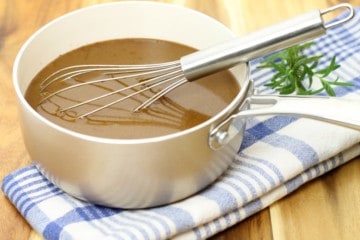
4. Tomato Sauce – Bright and Bold
Tomato sauce is probably the most popular and familiar of the five mother sauces. In French cuisine, it begins with fresh or canned tomatoes simmered with aromatics such as onions, garlic, and herbs. It can be left chunky or blended smooth. It serves as a base for countless pasta dishes, casseroles, and baked meals.
French-style tomato sauce is slightly different from Italian versions, but both are essential in homemade cooking. Once you’ve made it from scratch, you’ll never look at store-bought sauces again.
Traditionally flavored with herbs and aromatic vegetables, "sauce tomat" (now more popularly known as tomato sauce) was a general, all-purpose sauce that used to be thickened with a roux. Nowadays, it is more often simply reduced or pureed.
Serve it with poultry, pasta dishes, dumplings, vegetable dishes, polenta, or veal.
👉 Try our recipe: Homemade Tomato Sauce
Tomato Sauce Derivatives:
- Creole Sauce: To create this variation, add finely diced onion, sliced celery, diced green pepper, okra, green olives, and hot pepper sauce to the tomato base.
- Spanish Sauce: Add diced onion, celery, sweet peppers, garlic, sliced mushrooms, tomato concassée (roughly chopped tomatoes), and chilies to the tomato base.
- Provencal Sauce: Not technically a derivative, but part of the tomato sauce family, Provencal is made by sautéing tomato concassée (roughly chopped tomatoes) with garlic and shallots. It is then seasoned with herbs, salt, and pepper.
- Bolognese Sauce: Also not technically a derivative, bolognese sauce is made (traditionally) by cooking finely diced beef (modern recipes use ground beef) with onions, celery, herbs, and garlic before adding tomato sauce.
Homemade Tomato Sauce Recipe
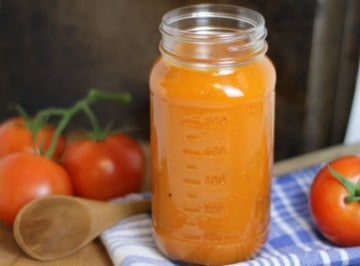
5. Hollandaise Sauce – Rich and Buttery
Hollandaise sauce is an emulsified sauce made with egg yolks, melted butter, and lemon juice. It’s known for its silky texture and bright, tangy flavor. While it can be a little tricky to master, it’s well worth the effort – and perfect for dishes like eggs Benedict, steamed asparagus, or roasted vegetables.
The key to hollandaise is gentle heat and constant whisking. Once you’ve got the technique down, you’ll have a go-to sauce for brunches, vegetables, and elegant dinners.
👉 Learn how to make it: Classic Hollandaise Sauce
Hollandaise Sauce Derivatives:
- Béarnaise Sauce: A classic variation made by infusing white wine vinegar with shallots, tarragon, and black pepper, then combining it with the traditional hollandaise base. Often served with steak or grilled meats.
- Maltese Sauce: A citrusy twist on hollandaise made by adding blood orange juice and zest. Typically served with asparagus or other steamed vegetables. Also great for sweet desserts.
- Foyot Sauce: Also known as Valois sauce, this version blends hollandaise with a rich meat glaze (glace de viande), making it ideal for grilled meats.
- Choron Sauce: A Béarnaise-based variation with tomato purée or concassée added. It has a creamy, tangy flavor and is often paired with grilled meats and fish.
- Noisette Sauce: A nutty version created by replacing regular butter with browned butter (beurre noisette) for a deeper, toasted flavor.
- Choron Sauce: Hollandaise sauce with tomato puree added.
- Dijon Sauce: Hollandaise sauce with Dijon mustard mixed in.
Homemade Hollandaise Sauce Recipe
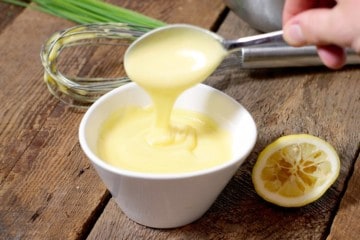
🎓 Quick Tip: Remember the 5 Mother Sauces with This Fun Mnemonic!
A little silly, but it sticks! Use this phrase to quickly recall all five mother sauces when you’re cooking or planning meals:
“Big Velvety Elephants Take Hikes”
B – Béchamel | V – Velouté | E – Espagnole | T – Tomato | H – Hollandaise

Recap
The five mother sauces aren’t just fancy old-fashioned French cooking – they’re the common basis for many great sauces that we love today.
Once you understand the foundation of each sauce, you can customize them with your own flavors, pair them with different ingredients, and create new dishes with confidence.
Whether you're whisking up a creamy béchamel for mac and cheese, stirring velouté into a chicken pot pie, or spooning hollandaise over brunch, these sauces make homemade cooking more delicious and open up a whole new world of tastes and culinary adventures.
Ready to get started? Choose a sauce and try it in your kitchen today using our step-by-step recipes. Happy cooking!

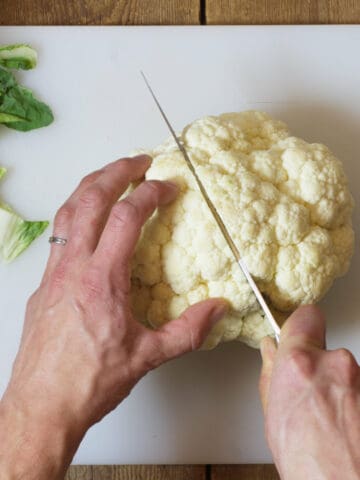
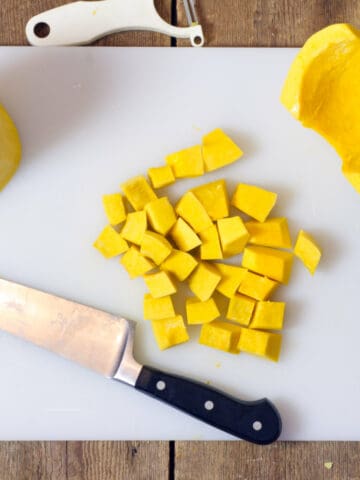
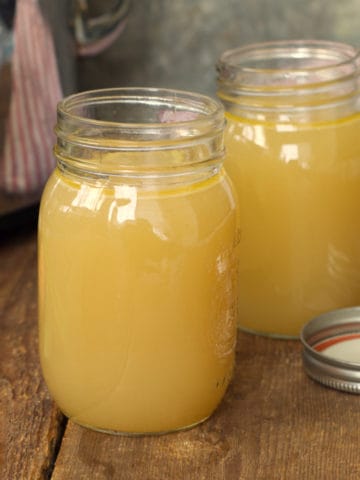
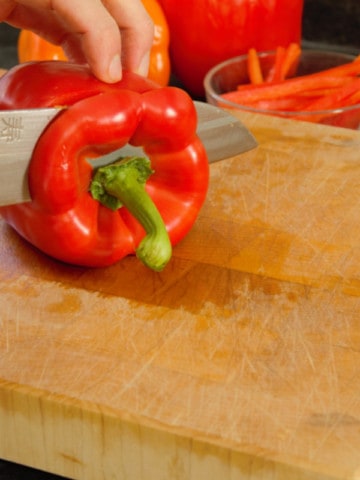
Comments
No Comments